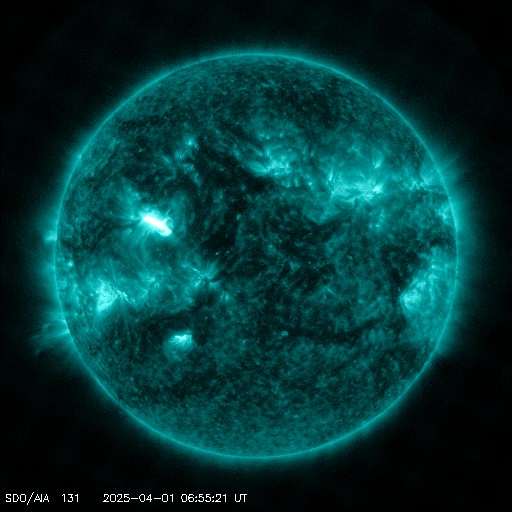Viewing archive of Tuesday, 20 May 2003
Solar activity report
Any mentioned solar flare in this report has a scaling factor applied by the Space Weather Prediction Center (SWPC). Because of the SWPC scaling factor, solar flares are reported as 42% smaller than for the science quality data. The scaling factor has been removed from our archived solar flare data to reflect the true physical units.
Report of Solar-Geophysical Activity 2003 May 20 2200 UTCPrepared by the NOAA © SWPC and processed by SpaceWeatherLive.com
Joint USAF/NOAA Report of Solar and Geophysical Activity
SDF Number 140 Issued at 2200Z on 20 May 2003IA. Analysis of Solar Active Regions and Activity from 19-2100Z to 20-2100Z
Solar activity was at low levels. Region 362 (S10E10)
produced a C1.4 flare at 1931Z. Region 362 was shown some growth
since yesterday and has increased in magnetic complexity to a
beta-gamma configuration. Region 364 (S24W40) produced three C1
flares and has shown growth in area coverage. New Region 365
(S06E68) was numbered today.
IB. Solar Activity Forecast
Solar activity is expected to be at
low levels. C-class activity is expected from Regions 362 and 364.
IIA. Geophysical Activity Summary 19-2100Z to 20-2100Z
The geomagnetic field was at unsettled levels with one period of
quiet conditions.
IIB. Geophysical Activity Forecast
The geomagnetic field is
expected to be at quiet to unsettled levels.
III. Event Probabilities 21 May to 23 May
| Class M | 10% | 10% | 15% |
| Class X | 01% | 01% | 01% |
| Proton | 01% | 01% | 01% |
| PCAF | green | ||
IV. Penticton 10.7 cm Flux
Observed 20 May 124 Predicted 21 May-23 May 125/135/140 90 Day Mean 20 May 123
V. Geomagnetic A Indices
Observed Afr/Ap 19 May 009/012 Estimated Afr/Ap 20 May 012/012 Predicted Afr/Ap 21 May-23 May 010/012-010/012-010/015
VI. Geomagnetic Activity Probabilities 21 May to 23 May
| A. Middle Latitudes | |||
|---|---|---|---|
| Active | 25% | 25% | 25% |
| Minor storm | 10% | 10% | 10% |
| Major-severe storm | 05% | 05% | 05% |
| B. High Latitudes | |||
|---|---|---|---|
| Active | 35% | 35% | 35% |
| Minor storm | 15% | 15% | 15% |
| Major-severe storm | 05% | 05% | 05% |
All times in UTC
Current data suggests there is a slight possibility for aurora to appear at the following high latitude regions in the near future
Gillam, MB, Yellowknife, NTLatest news
Latest forum messages
AR4048 57Similar AR 3664 vs AR 4048 ??? 6Temporary Topic - Ongoing Solar Proton Events 5Unspecified geomagnetic activity 2176NOAA space weather enthusiasts darhboard 4
More topicsSupport SpaceWeatherLive.com!
A lot of people come to SpaceWeatherLive to follow the Sun's activity or if there is aurora to be seen, but with more traffic comes higher server costs. Consider a donation if you enjoy SpaceWeatherLive so we can keep the website online!

Latest alerts
07:15 UTC - 10cm Radio Burst
Begin Time: 01/04/2025 06:45 UTC Maximum Time: 01/04/2025 06:45 UTC Duration: 1 minutes. Peak flux: 190 sfu
07:06 UTC - Solar flare
Strong M5.61 flare
06:48 UTC - Radio Blackout
Moderate R2 radio blackout in progress (≥M5 - current: M5.36)
06:45 UTC - Radio Blackout
Minor R1 radio blackout in progress (≥M1 - current: M1.7)
02:15 UTC - Solar protons
Moderate S2 Solar Radiation Storm - Infrequent effects on HF radio through polar regions and satellite operations
Space weather facts
| Last X-flare | 2025/03/28 | X1.1 |
| Last M-flare | 2025/03/31 | M1.2 |
| Last geomagnetic storm | 2025/03/27 | Kp5 (G1) |
| Spotless days | |
|---|---|
| Last spotless day | 2022/06/08 |
| Monthly mean Sunspot Number | |
|---|---|
| February 2025 | 154.6 +17.6 |
| Last 30 days | 128.5 -22.7 |



